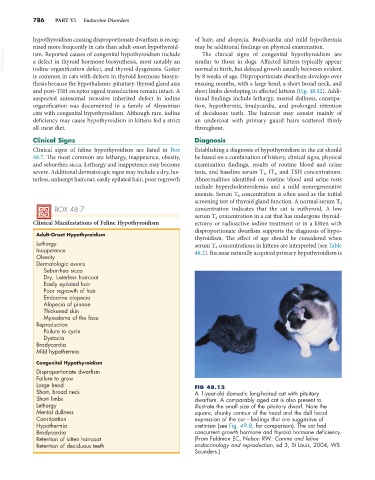Page 814 - Small Animal Internal Medicine, 6th Edition
P. 814
786 PART VI Endocrine Disorders
hypothyroidism causing disproportionate dwarfism is recog- of hair; and alopecia. Bradycardia and mild hypothermia
nized more frequently in cats than adult-onset hypothyroid- may be additional findings on physical examination.
VetBooks.ir ism. Reported causes of congenital hypothyroidism include similar to those in dogs. Affected kittens typically appear
The clinical signs of congenital hypothyroidism are
a defect in thyroid hormone biosynthesis, most notably an
iodine organification defect, and thyroid dysgenesis. Goiter
by 8 weeks of age. Disproportionate dwarfism develops over
is common in cats with defects in thyroid hormone biosyn- normal at birth, but delayed growth usually becomes evident
thesis because the hypothalamic-pituitary-thyroid gland axis ensuing months, with a large head, a short broad neck, and
and post-TSH receptor signal transduction remain intact. A short limbs developing in affected kittens (Fig. 48.12). Addi-
suspected autosomal recessive inherited defect in iodine tional findings include lethargy, mental dullness, constipa-
organification was documented in a family of Abyssinian tion, hypothermia, bradycardia, and prolonged retention
cats with congenital hypothyroidism. Although rare, iodine of deciduous teeth. The haircoat may consist mainly of
deficiency may cause hypothyroidism in kittens fed a strict an undercoat with primary guard hairs scattered thinly
all-meat diet. throughout.
Clinical Signs Diagnosis
Clinical signs of feline hypothyroidism are listed in Box Establishing a diagnosis of hypothyroidism in the cat should
48.7. The most common are lethargy, inappetence, obesity, be based on a combination of history, clinical signs, physical
and seborrhea sicca. Lethargy and inappetence may become examination findings, results of routine blood and urine
severe. Additional dermatologic signs may include a dry, lus- tests, and baseline serum T 4 , fT 4 , and TSH concentrations.
terless, unkempt haircoat; easily epilated hair; poor regrowth Abnormalities identified on routine blood and urine tests
include hypercholesterolemia and a mild nonregenerative
anemia. Serum T 4 concentration is often used as the initial
screening test of thyroid gland function. A normal serum T 4
BOX 48.7 concentration indicates that the cat is euthyroid. A low
serum T 4 concentration in a cat that has undergone thyroid-
Clinical Manifestations of Feline Hypothyroidism ectomy or radioactive iodine treatment or in a kitten with
disproportionate dwarfism supports the diagnosis of hypo-
Adult-Onset Hypothyroidism thyroidism. The effect of age should be considered when
Lethargy serum T 4 concentrations in kittens are interpreted (see Table
Inappetence 48.2). Because naturally acquired primary hypothyroidism is
Obesity
Dermatologic events
Seborrhea sicca
Dry, lusterless haircoat
Easily epilated hair
Poor regrowth of hair
Endocrine alopecia
Alopecia of pinnae
Thickened skin
Myxedema of the face
Reproduction
Failure to cycle
Dystocia
Bradycardia
Mild hypothermia
Congenital Hypothyroidism
Disproportionate dwarfism
Failure to grow
Large head FIG 48.12
Short, broad neck A 1-year-old domestic long-haired cat with pituitary
Short limbs dwarfism. A comparably aged cat is also present to
Lethargy illustrate the small size of the pituitary dwarf. Note the
Mental dullness square, chunky contour of the head and the dull facial
Constipation expression of the cat—findings that are suggestive of
Hypothermia cretinism (see Fig. 49.8, for comparison). The cat had
Bradycardia concurrent growth hormone and thyroid hormone deficiency.
Retention of kitten haircoat (From Feldman EC, Nelson RW: Canine and feline
Retention of deciduous teeth endocrinology and reproduction, ed 3, St Louis, 2004, WB
Saunders.)

